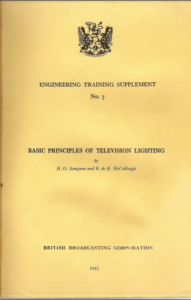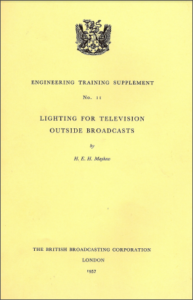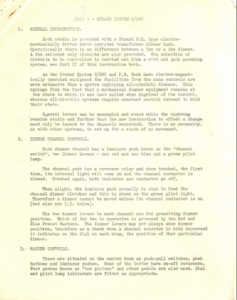Lighting for Television has to fulfill two very different functions.
The first role of the lighting engineer is to provide sufficient illumination for the Television camera pick-up tubes to generate a picture suitable for broadcast transmission. The various camera tubes varied in the amount of light input that they required: the monochrome cameras of the first three “generations” (Emitron, CPSEmitron, 3 and 4.5 inch Image Orthicon and so on) required a lot of light: see the section on camera pickup tube reprints. Importantly, the lighting had to be suitable strong, but also avoid throwing shadows from equipment, scenery and other actors. One critical thing to avoid were microphone boom shadows.
However, equally (if not more) important, the lighting supervisor had to work with the programme director and art director (etc) to help build the mood required for each scene: dramatic lighting, spooky lighting, bright summer’s day lighting. The studio lighting engineer had to make a studio set look like a real location: the outside broadcast lighting engineer had to prevent an outside location looking like a studio set!
This page includes two documents that are not reprints, but BBC originated booklets intended to extend any training given at Wood Norton Hall or consolidate any on-the-job training which may have been given. There were a number of these Engineering Training Supplements. Two important “Supplements” are included here: Television Lighting for Studio-based Television programmes, and lighting for programmes from any “outside” location (as in “outside” of the studio).
Other reprints in this section describe the physical lighting units and control mechanisms availaible to the lighting engineer – or Technical Manager 1 (TM1).
 |
Basic Principles of Television Lighting |
| This manual does not describe nor recommend any standardised code of procedure for the lighting of Television productions.
The effective application of lighting to entertainment demands a high degree of imagination coupled with great flexibility of technique in face of the ever-changing problems of studio presentation. Any attempt to impose a systematised routine, or to save imaginative effort by listing a series of foolproof lighting recipes as is done in some photographic books, will, in the writers’ opinion, ultimately reduce the visual effectiveness of the programmes. Accordingly, the rules and procedures discussed in this book must be considered solely as exercises for the beginner; he will not become an expert until he knows when to forget them.
|
 | Lighting for Television Outside Broadcasts |
| This Engineering Supplement extends the description of Television Lighting to Outside Broadcasts.
The O.B. team is usually presented with the real place, and the problem becomes how to supplement the existing conditions of light to satisfy technical requirements while still preserving the reality. The effort on the part of the lighting supervisor in the studio to create reality out of unreality, as opposed to the effort on the part of the O.B.lighting supervisor not to create unreality out of reality, is perhaps the most fundamental difference between studio and O.B. approach and it is a difference which should be very fully appreciated.
|
 |
Television Studio Lighting Equipment |
| This paper summarises the present state of development in lighting equipment for television studios in Great Hritain, with particular reference to the studios of the BBC, and outlines the rapid progress whitch has been made in recent years in the mechanisation and flexibke control of this equipment. This development has included improvements in the mechanical handling nf luminaires, the introduction of remote-cuutrolled dimming and switching systems, and improvements in studio luminaires themselves.
The difficulties in lighting a television production effectively arc outlined and the paper shows how these difficulties can be minimised by equipment specifically designed Ior the purpose. Thc equipmcnt used can be shown to have developed logically from that designed for filming and for the stage, but modified to meet the special requirements of television. Light sources are discussed and the paper shows that the tungsten lamp remains the most suitable for this application, although fluorescent lamps and carbon arcs are used for special purposes.
|
 |
Strand System C/BBC Part I |
| Each studio is provided with a Strand P.R. type electro-mechanically driven servo operated transformer dimmer bank.
Operationally there is no difference between a 5kw or a 2kw dimmer. A few switohed only circuits are a1so provided. The selection of cirouits to be controlled is carried out from a cord and jack patching system, see Part I1 of this instruction book, As the Strand System C/BBC and P.R. Bank uses electro-magnetically operated equipment the facilities from the same oontrols are more extensive than a system employing all-electric dimmers. This springs from the fact that a mechanioal dimmer equipment remains at the state to which it was last called when deprived of its control, whereas all-electric systems require constant control current tc hold their state. Control levers can be uncoupled and reset while the lighting remains statio and further that the new instruction to effeot a change need only be issued to the channels ooncerned. There is no necessity, as with other systems, to set up for a state of no movement.
|
Back to top
Back to reprint index



